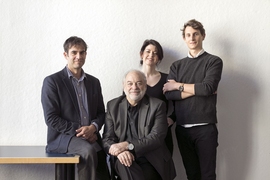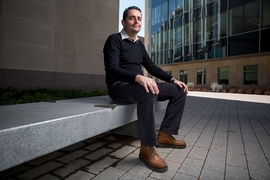A new lab in the MIT Center for Real Estate (CRE) will link the creation of the built environment to economic impact, seeking to identify innovations in design and technology that will determine the future of communities and cities.
The MIT Real Estate Innovation Lab (REIL) will explore three areas: innovations in building design that lead to new building types and urban forms; new processes in construction such as 3-D printing and modular construction; and new data technologies with the potential to transform the organization of cities and the built environment.
“Thirty years ago, green buildings were a cutting-edge concept. Today they are the standard, not only due to their environmental benefits but because there is evidence that justifies the economic investment,” says Andrea Chegut, research scientist and director of the new lab. “Our goal will be to understand what is happening at the frontier of the built environment today, to produce statistical and empirical evidence of approaches that work, and to translate these innovations into widespread use.”
The lab’s principal investigators are Dennis Frenchman, the Class of 1922 Professor of Urban Design and Planning, and David Geltner, professor of real estate finance and engineering systems. The lab also provides an opportunity for MIT School of Architecture and Planning graduate students, PhD candidates, and postdocs to contribute and collaborate in an entrepreneurial setting that combines expertise in advanced methodologies of statistics, computational architecture, economics, urban design, and other disciplines.
“This new lab creates a dynamic environment for scholars to conduct research that will weave together the many disciplines within the School of Architecture and Planning that contribute to the development of innovative products, spaces, and communities,” says Albert Saiz, director of the CRE and the Daniel Rose Associate Professor of Urban Economics and Real Estate. “When you link these scholars and practitioners together, you start to see the full landscape of the frontier. We believe this is the first academic lab to bring these disciplines together with this ambition.”
Industry and corporate collaborations — from real estate development and construction to big data and architecture — are important to the researchers, says Geltner, because they are the stakeholders who develop cities and communities. Accompanying the launch of the new lab is the announcement of its founding industry partner, JLL, the leading professional services firm specializing in real estate.
JLL is engaging with REIL to develop an open-innovation strategy to disseminate academic research to the urban technology community. “JLL and the MIT Center for Real Estate have a shared mission — and a passion — for innovation and real estate,” said Ben Breslau, JLL’s managing director of research. “As an industry partner, we look forward to engaging with the brilliant minds at MIT to support research that will create a better future.”
Architects and designers can introduce novel ideas from 3-D printed buildings to indoor vertical food farms, but to develop these projects, they have to make the case to the investors that will fund them. However, says Chegut, new technologies and systems may not have diffused through the market enough to offer sufficient assurance to investors. “If you are going to get meaningful projects off the ground, you must have the financial stakeholders on board,” she says. “We hope to contribute analysis and evidence that helps innovators and investors come together.”
The big data revolution is finally coming to the built environment, says Frenchman, noting that venture capital investment in urban technology firms has gone from $200,000 per year in 2008 to $1.8 billion today. “These tech companies are building digital platforms and scraping data to show us the city in a new form,” he says.
Embracing this new diversity of data, one of the lab’s flagship projects is to create a comprehensive real estate database for the entire city of New York. By assembling any data that describes the city — such as rents, transaction prices, building mortgages, vacant space, Airbnb locations, co-working spaces, cell towers, fiber-optic cables, subway lines, and more — the database will offer a way to “hack the city,” Chegut says. “Each source represents a distinct view of a city, whether from architects, urban planners, real estate developers, economists, construction firms, utilities, or investors. Capturing the full complexity of these overlapping and interconnected sets of data will offer an unprecedented platform for insight because it will integrate multiple perspectives into one resource.”
One sign of the database’s potential for impact is the interest it is already receiving. “Many data providers are committing to share their data with us to help illustrate these links,” says Weikal. “They understand that sharing their information will help everyone build better cities.”
The lab will also explore how changes in the built environment over time help create an atmosphere for innovation to occur. “We used to build factories, then office parks, then media cities, and now we are building innovation cities,” says Frenchman. By examining locations all over the world with successful innovation districts — including Cambridge, Massachusetts; Seoul, South Korea; Medellín, Colombia; Mexico City, Mexico; Barcelona, Spain; and Beijing, China — the project will identify how they benefit cities in terms of jobs and development, as well as inform urban design.
The new lab plans on releasing at least a half-dozen papers exploring these phenomena this year and will link this research to DesignX, a new entrepreneurship accelerator in the School of Architecture and Planning that provides training, tools, and resources to student teams building companies and organizations focused on design and the built environment.
By applying knowledge generated from the lab’s research to educate students in the DesignX program, the lab can help foster new technologies that will address gaps in the marketplace. “If we have a number of pieces of the puzzle, but one is missing, we can say to young entrepreneurs, ‘Run that way, fast,’” says Frenchman. “Our research can point innovators toward the frontier.”
By foregrounding the business case for innovation, Chegut hopes that the lab can help to give architects, urban planners, and developers the tools they need to succeed with their most transformative ideas. “This kind of R&D is the lifeblood of MIT,” says Chegut. “Designers are asked to justify every intervention they make. By getting architects and economists together, we can propose design innovations that not only support viable urban economies but also lead to vibrant and successful communities.”








